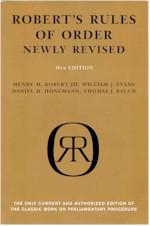 |
|
|
| ||||||
|
|
This page is the original source of this review, though you may also find it on Amazon or other sites. | ||
| Book Reviews Home | Free Audio Books | |
 |
Book Review of: Robert's Rules of Order, 10th EditionPrice: $12.24 Availability: Usually ships
within 24 hours |
| Review
of
Robert's Rules of Order, 10th Edition, by Henry M. Roberts III, William J. Evans, Daniel H. Honemann, Thomas J. Balch (Softcover, 2000) Reviewer: Mark Lamendola, author of over 6,000 articles; member or former member of several boards, committees, and subcommittees; former officeholder of a variety of executive offices in various organizations. I find it appropriate that this book has a gold cover. Following the old cliché, it's worth its weight in gold. Having been involved at all levels in various organizations operating in various venues, I have found that 98% of the headaches that arise are due to someone's ignorance of the rules of how to "play nice with others" who are also on a given committee, board, or panel. People who don't take the time to learn Robert's Rules of Order have no business serving on a committee, board, or panel. Such people do more harm than good. They hurt people's feelings and propagate misunderstandings. They create rework, pointless discussion, and inefficiencies. All of these problems would have been prevented by applying the basics of Robert's Rules of Order. A person can choose to learn the basic rules by observing, but such learning would occur over too much time for that approach to work well. It's much better to just buy your own copy of Robert's Rules of Order and study selected parts for a few minutes a day over the course of a week or so. Some folks object to using Robert's Rules of Order on the grounds the rules are too formal or too hard to learn. These objections are not valid, because the rules are not overly formal and are fairly easy to learn. Another objection is the rules create too much of an administrative burden. Again, not true. The reality is the rules facilitate communication and reduce administrative burdens. The rules provide a flexible structure that any organization is free to modify, but less modification means less of a learning curve for people new to the organization. I have served on bylaws committees in which we did modify Robert's Rules, mostly because the rules are still based on face to face meetings when electronic meetings are increasingly the norm. Yet, the same principles apply--only a few details need to change.
Yes, the book is thick. This can lead people to think it's full of stuff to memorize. But, the core of what's needed for the typical organization member is relatively small and all of it makes sense. Making things even easier for the reader, the book explains the rationale behind the rules as you go. The bulk of the book consists of "extra stuff" that falls outside of what a person normally needs to know. But the core is actually pretty light. So, don't be intimidated by the page count. As you might expect, Robert's Rules of Order is, well, orderly. It consists of 20 sections. An astute reader can quickly pick out which sections are applicable for studying right away, and which should be reference later. The former far outweighs the latter, for the typical board member or meeting attendee. If you want to succeed as a member of a board, committee, or panel (or if you simply don't want to be a pain to everyone else), this book is a resource you must have. | |
About these reviewsYou may be wondering why the reviews here are any different from the hundreds of "reviews" posted online. Notice the quotation marks? I've been reviewing books for sites like Amazon for many years now, and it dismays me that Amazon found it necessary to post a minimum word count for reviews. It further dismays me that it's only 20 words. If that's all you have to say about a book, why bother? And why waste everyone else's time with such drivel? As a reader of such reviews, I feel like I am being told that I do not matter. The flippancy of people who write these terse "reviews" is insulting to the authors also, I would suspect. This sound bite blathering taking the place of any actual communication is increasingly a problem in our mindless, blog-posting Webosphere. Sadly, Google rewards such pointlessness as "content" so we just get more if this inanity. My reviews, contrary to current (non) standards, actually tell you about the book. I always got an "A" on a book review I did as a kid (that's how I remember it anyhow, and it's my story so I'm sticking to it). A book review contains certain elements and has a logical structure. It informs the reader about the book. A book review may also tell the reader whether the reviewer liked it, but revealing a reviewer's personal taste is not necessary for an informative book review. About your reviewer
About reading styleNo, I do not "speed read" through these. That said, I do read at a fast rate. But, in contrast to speed reading, I read everything when I read a book for review. Speed reading is a specialized type of reading that requires skipping text as you go. Using this technique, I've been able to consistently "max out" a speed reading machine at 2080 words per minute with 80% comprehension. This method is great if you are out to show how fast you can read. But I didn't use it in graduate school and I don't use it now. I think it takes the joy out of reading, and that pleasure is a big part of why I read. |
| |||||